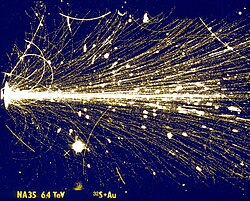Physics:NA35 experiment
The NA35 experiment was a particle physics experiment that took place in the North Area of the Super Proton Synchrotron (SPS) at CERN. It used a streamer chamber with comprehensive hadronic and electromagnetic calorimetry. This experiment was used to observe the properties of nucleus-nucleus collisions at 60 and 200 GeV/nucleon, to understand the degree of stopping and thermalization, determine the energy densities achievable in those conditions, and to measure other related properties and quantities.[1] The first signature of quark–gluon plasma was observed by the NA35 experiment in 1995.[2][3]
The NA35 experiment was approved on 03 February 1983 and completed on 31 May 1999. It was succeeded by the NA49 experiment. The spokesperson for the experiment was Peter Seyboth.[4][5]
See also
- NA34/3 experiment
- NA36 experiment
- NA49 experiment
- NA61 experiment
- List of SPS experiments
References
- ↑ Search for the quark-gluon plasma - The NA35 experiment at the CERN SPS
- ↑ Alber, T.; Appelshäuser, H.; Bächler, J.; Bartke, J.; Białkowska, H.; Bloomer, M.A.; Bock, R.; Braithwaite, W.J. et al. (1996). "Antibaryon production in sulphur-nucleus collisions at 200 GeV per nucleon". Physics Letters B 366 (1–4): 56–62. doi:10.1016/0370-2693(95)01379-2. ISSN 0370-2693. Bibcode: 1996PhLB..366...56A.
- ↑ Rafelski, Johann (2020). "Discovery of Quark-Gluon Plasma: Strangeness Diaries". The European Physical Journal Special Topics 229 (1): 1–140. doi:10.1140/epjst/e2019-900263-x. ISSN 1951-6355. Bibcode: 2020EPJST.229....1R.
- ↑ Study of Relativistic Nucleus-Nucleus Collisions at the CERN SPS
- ↑ (Ions/Streamer Ch.)
External links
- Results from NA35
- CERN-NA-35 experiment record on INSPIRE-HEP
 |


